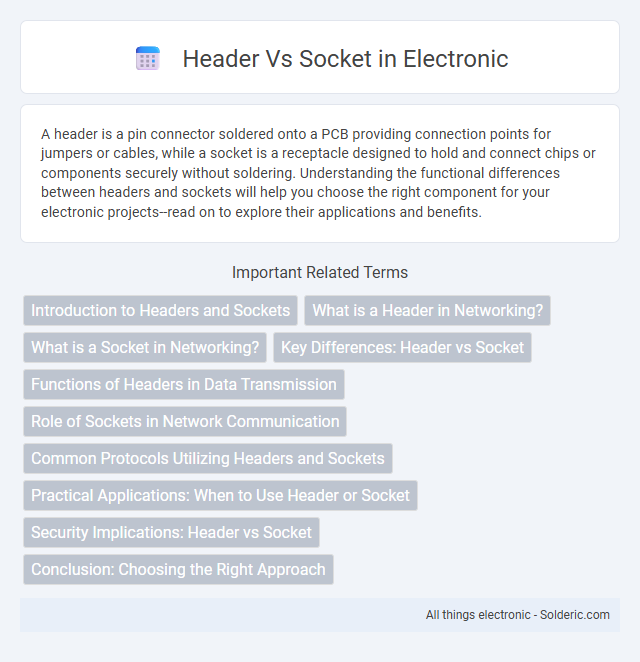A header is a pin connector soldered onto a PCB providing connection points for jumpers or cables, while a socket is a receptacle designed to hold and connect chips or components securely without soldering. Understanding the functional differences between headers and sockets will help you choose the right component for your electronic projects--read on to explore their applications and benefits.
Comparison Table
| Feature | Header | Socket |
|---|---|---|
| Definition | Fixed connector with multiple pins or contacts. | Receives and holds a plug or component firmly. |
| Usage | Permanent PCB mounting for connection points. | Allows easy insertion/removal of components or ICs. |
| Common Types | Pin headers, box headers, shrouded headers. | Zero Insertion Force (ZIF), DIP sockets, PGA sockets. |
| Installation | Soldered directly to PCB. | Mounted on PCB, accommodates removable devices. |
| Advantages | Simple, cost-effective, compact. | Protects IC pins, supports easy replacement. |
| Disadvantages | Not ideal for frequent component swapping. | More expensive, larger footprint. |
| Typical Applications | Permanent connections, jumper settings. | Prototyping, IC testing, upgradeable modules. |
Introduction to Headers and Sockets
Headers are connectors with multiple pins used to establish electrical connections on printed circuit boards (PCBs), enabling communication between components. Sockets are receptacles designed to hold and interface with headers or integrated circuits securely, allowing easy insertion and removal. Both headers and sockets are critical in electronic assembly for modularity and repairability.
What is a Header in Networking?
A header in networking is a crucial portion of a data packet that contains control information, such as source and destination addresses, error-checking codes, and protocol-specific details. It enables devices to correctly route and process data across complex network systems, ensuring accurate communication between nodes. Understanding the header's structure helps you troubleshoot network issues and optimize data transmission efficiency.
What is a Socket in Networking?
A socket in networking is a software endpoint that enables communication between two devices over a network, created by combining an IP address and a port number. It functions as a crucial interface for sending and receiving data packets using protocols such as TCP or UDP. Sockets facilitate real-time data exchange and establish connections necessary for services like web browsing, email, and file transfers.
Key Differences: Header vs Socket
Headers are fixed connectors with multiple pins soldered directly onto a PCB, enabling permanent electrical connections, while sockets provide removable interfaces designed to hold and connect pins or integrated circuits securely. Headers typically serve as male connectors, allowing flexible component interfacing, whereas sockets act as female connectors, facilitating easy replacement or upgrading of components without soldering. The key differences lie in permanence, connection type, and ease of component interchangeability in electronic assemblies.
Functions of Headers in Data Transmission
Headers in data transmission serve as essential metadata carriers, containing critical information such as source and destination addresses, protocol details, and error-checking codes to ensure accurate and efficient delivery of data packets. They enable proper routing by guiding packets through complex networks and facilitate data reassembly by indicating sequence numbers for fragmented transmissions. Headers also support flow control and security features, making them vital for maintaining the integrity and performance of communication protocols.
Role of Sockets in Network Communication
Sockets serve as fundamental endpoints for sending and receiving data across network connections, enabling seamless communication between devices over various protocols such as TCP and UDP. They facilitate the establishment, management, and termination of network connections by binding IP addresses and port numbers, ensuring accurate data routing. This functionality is critical in client-server architectures, allowing applications to interact by transmitting data packets reliably and efficiently.
Common Protocols Utilizing Headers and Sockets
Common protocols utilizing headers and sockets include HTTP, TCP/IP, and UDP, where headers define packet structure and sockets manage communication endpoints. Protocols like HTTP use headers to convey metadata such as content type and length, while sockets enable data transmission between client and server applications. Understanding these components improves your ability to troubleshoot and optimize network communication.
Practical Applications: When to Use Header or Socket
Headers are ideal for fixed, permanent connections in electronic circuits, such as mounting sensors or connecting microcontroller shields, where stability and durability are essential. Sockets provide flexibility for frequent component replacements or upgrades, commonly used in CPU installations and IC testing environments, allowing easy insertion and removal without soldering. Choosing between a header or socket depends on the application's requirement for either a stable, fixed connection or a modular, interchangeable interface.
Security Implications: Header vs Socket
Headers convey metadata within HTTP requests and responses, making them vulnerable to attacks like header injection, cross-site scripting (XSS), and man-in-the-middle (MITM) exploits if not properly validated or encrypted. Sockets establish a lower-level connection between devices, exposing risks such as unauthorized access, data interception, and denial-of-service (DoS) attacks, particularly if encryption and authentication are lacking. Implementing TLS/SSL for sockets and validating headers with strict controls significantly enhances security by mitigating these vulnerabilities.
Conclusion: Choosing the Right Approach
Selecting the right approach between headers and sockets depends on the specific application requirements, including communication protocols, data transfer speed, and hardware compatibility. Headers are ideal for structured, multi-pin connections in embedded systems, offering reliable signal integrity and ease of assembly. Sockets provide flexibility and durability for removable components, making them suitable for applications requiring frequent maintenance or upgrades.
Header vs Socket Infographic

 solderic.com
solderic.com